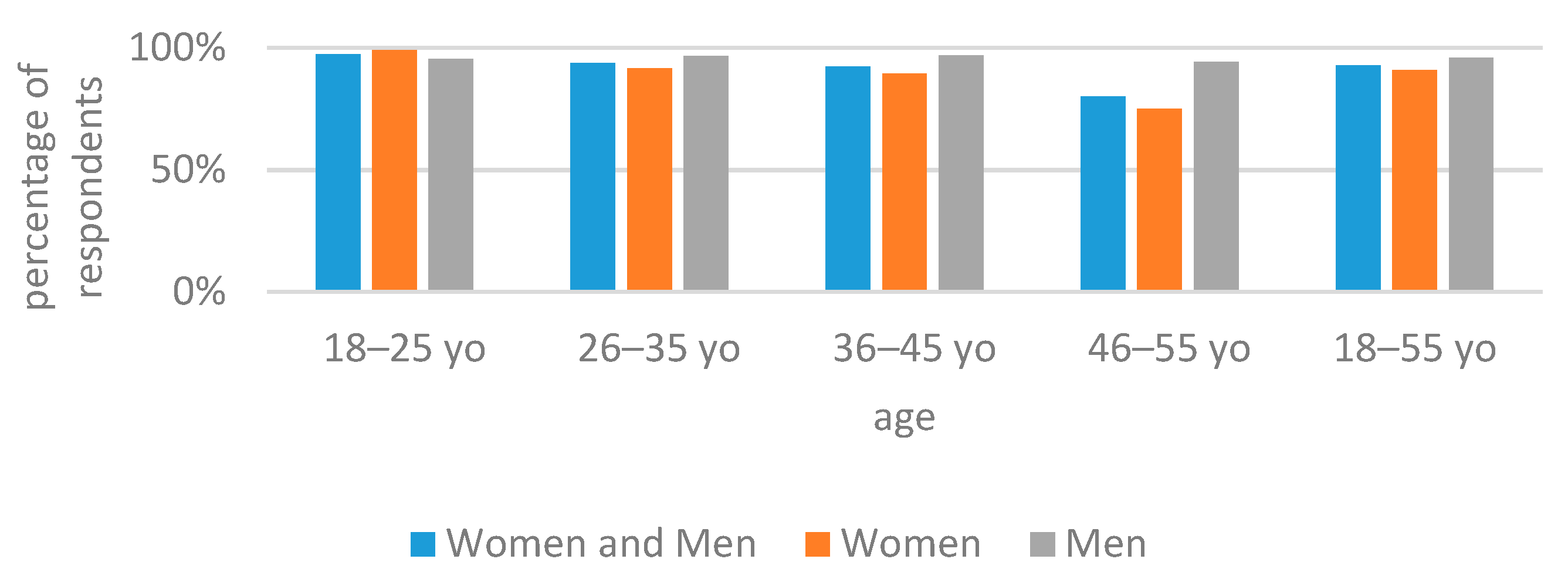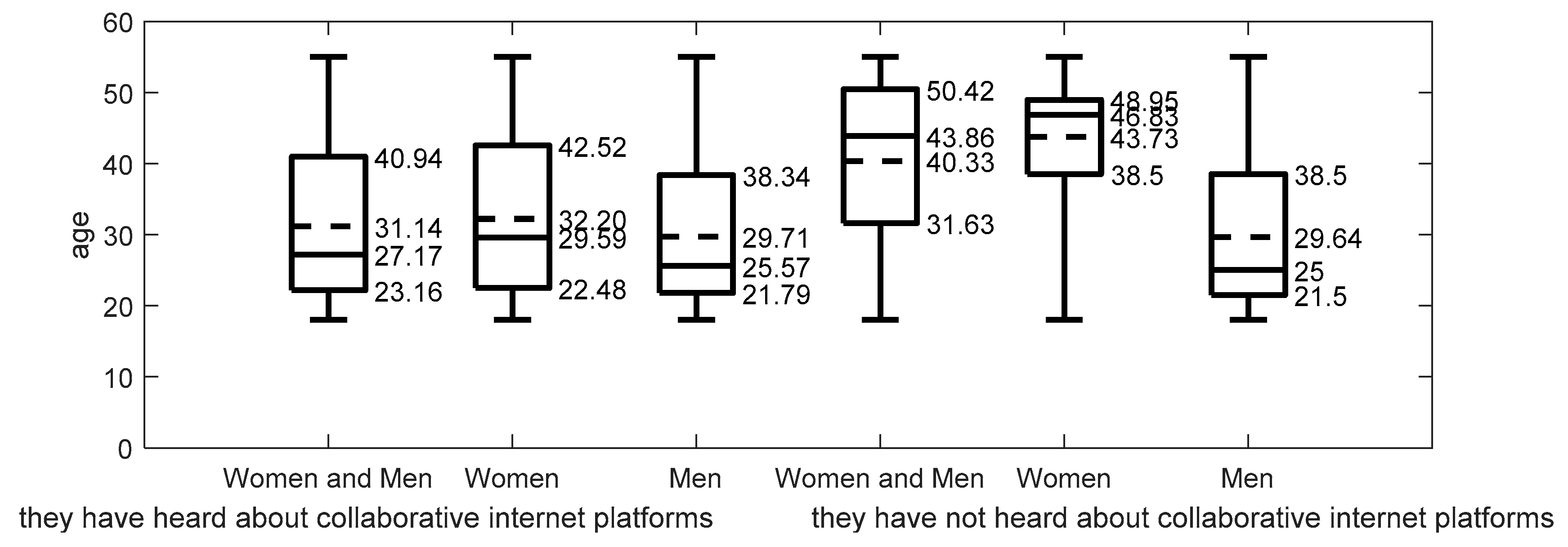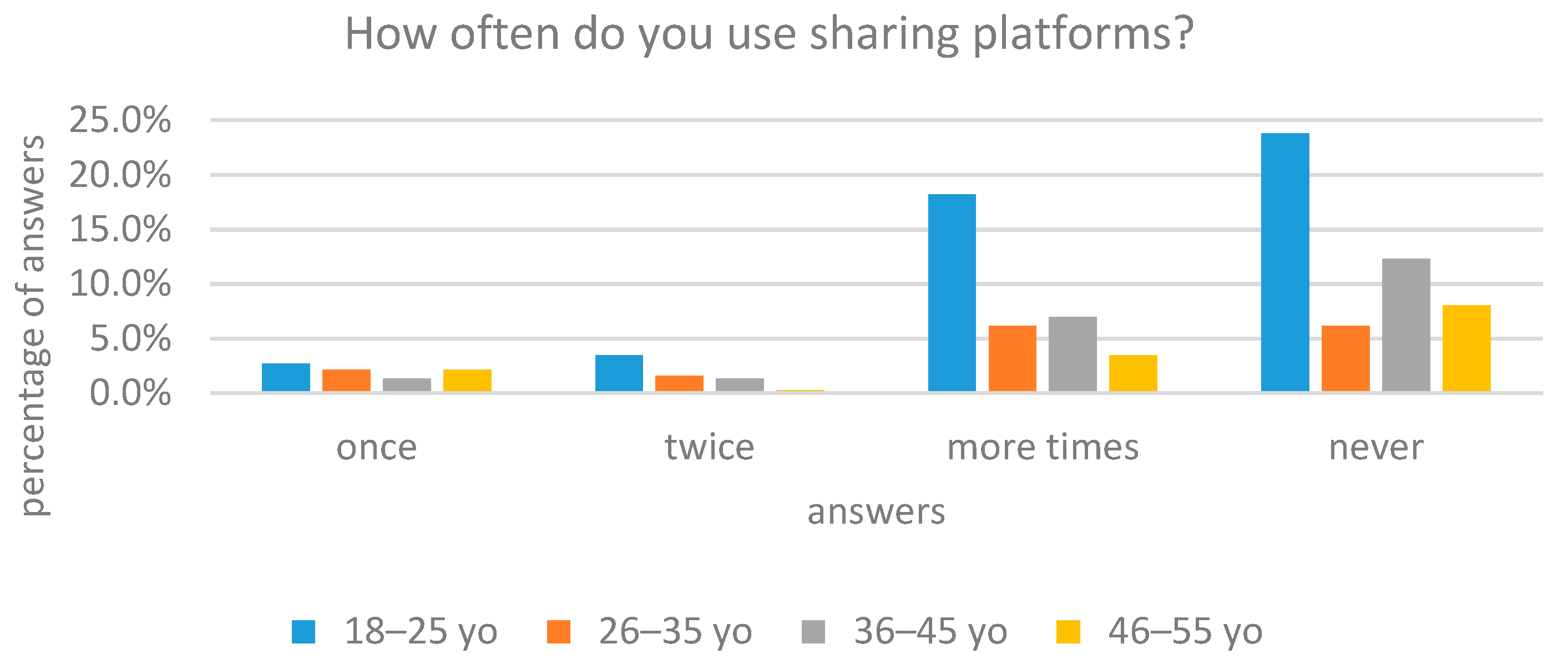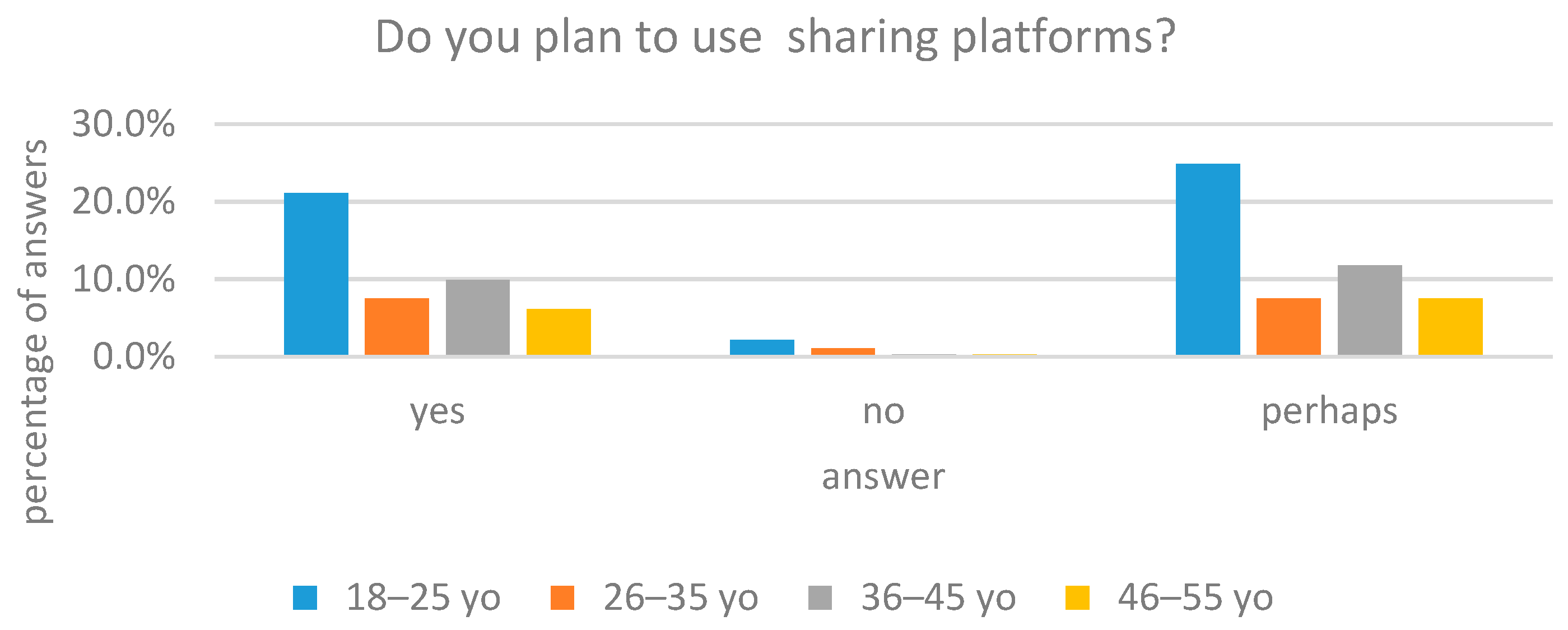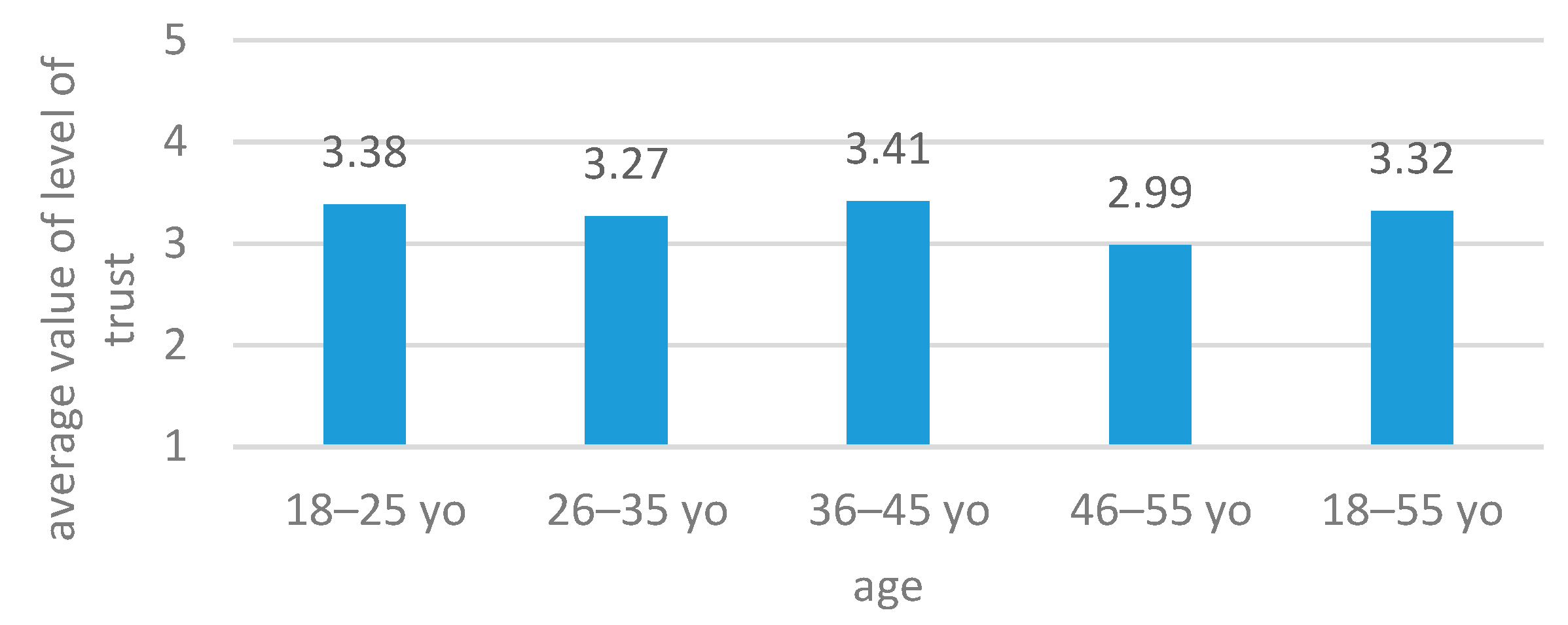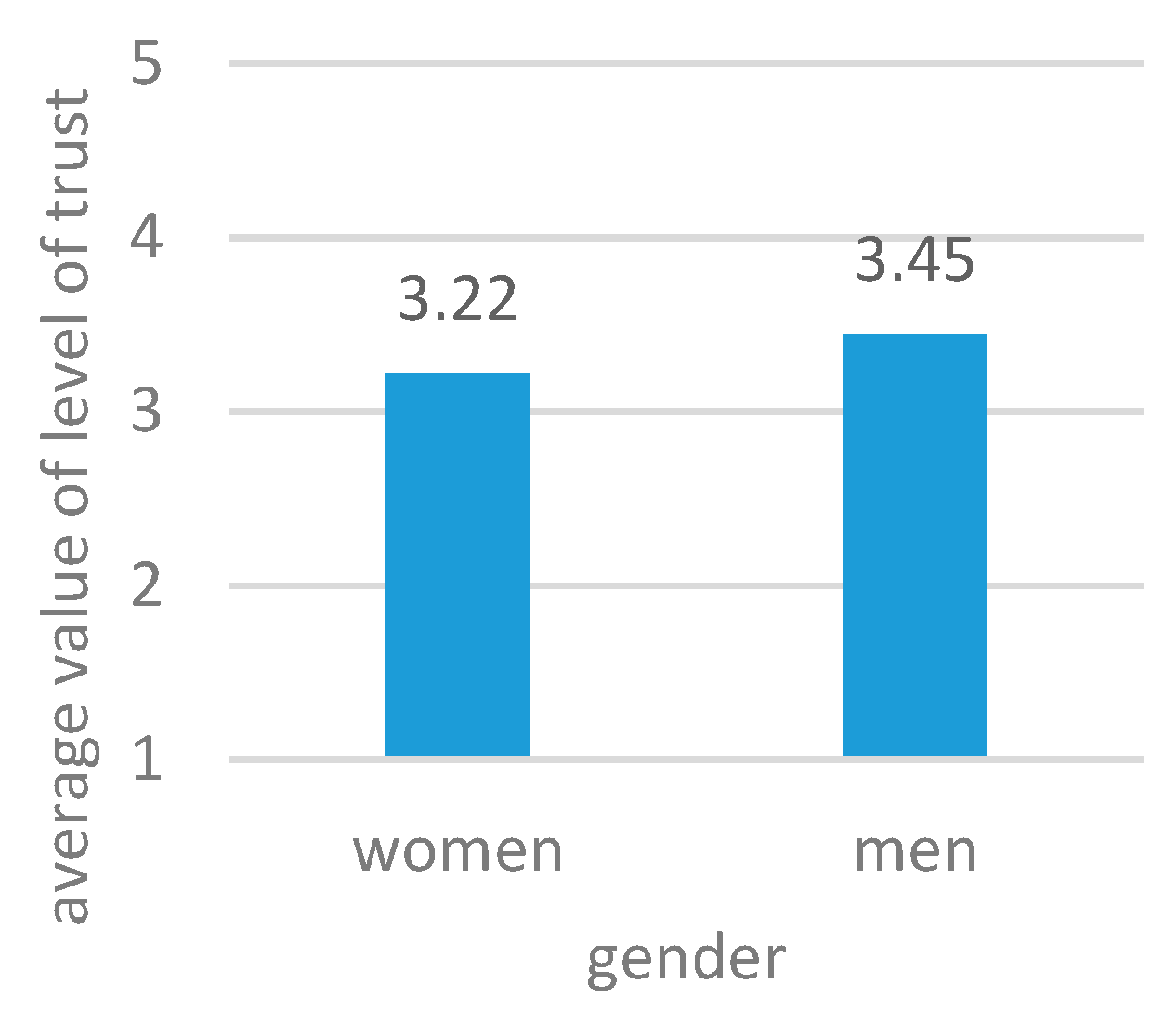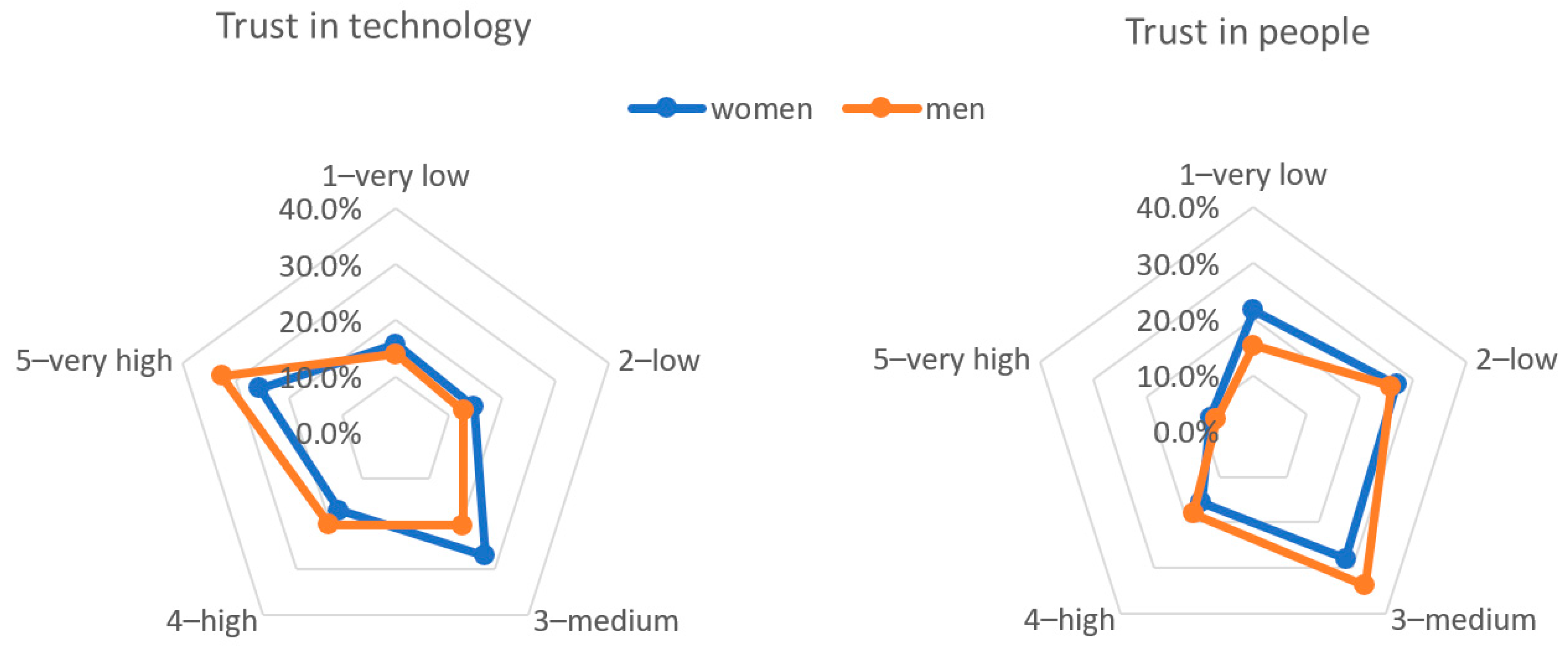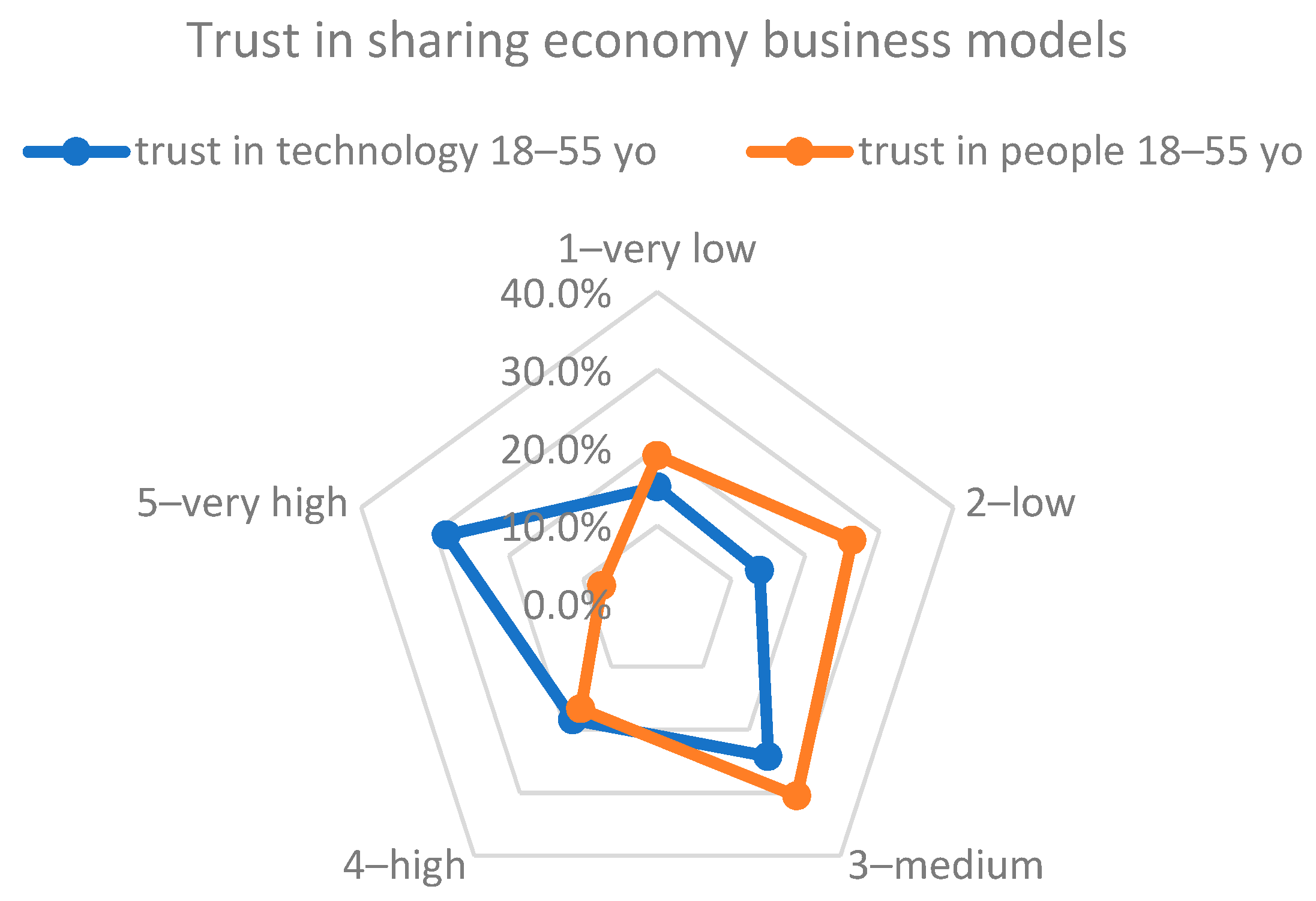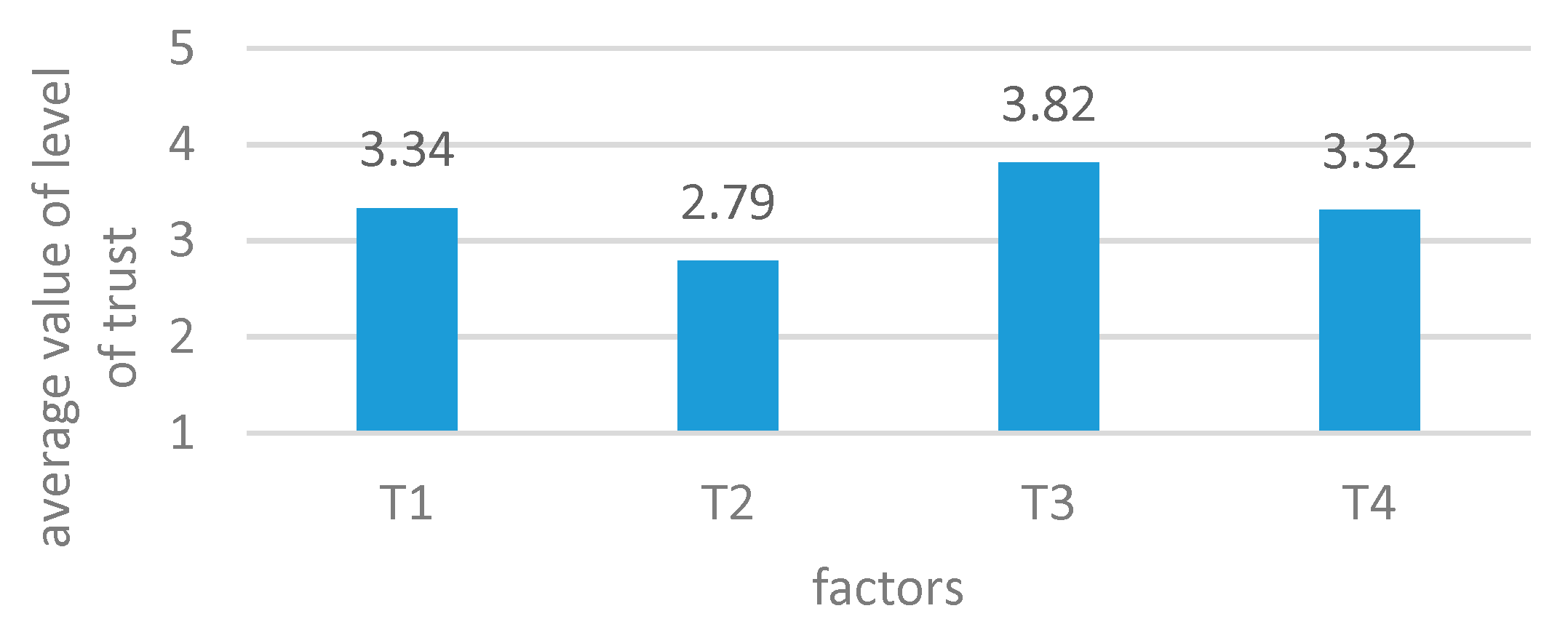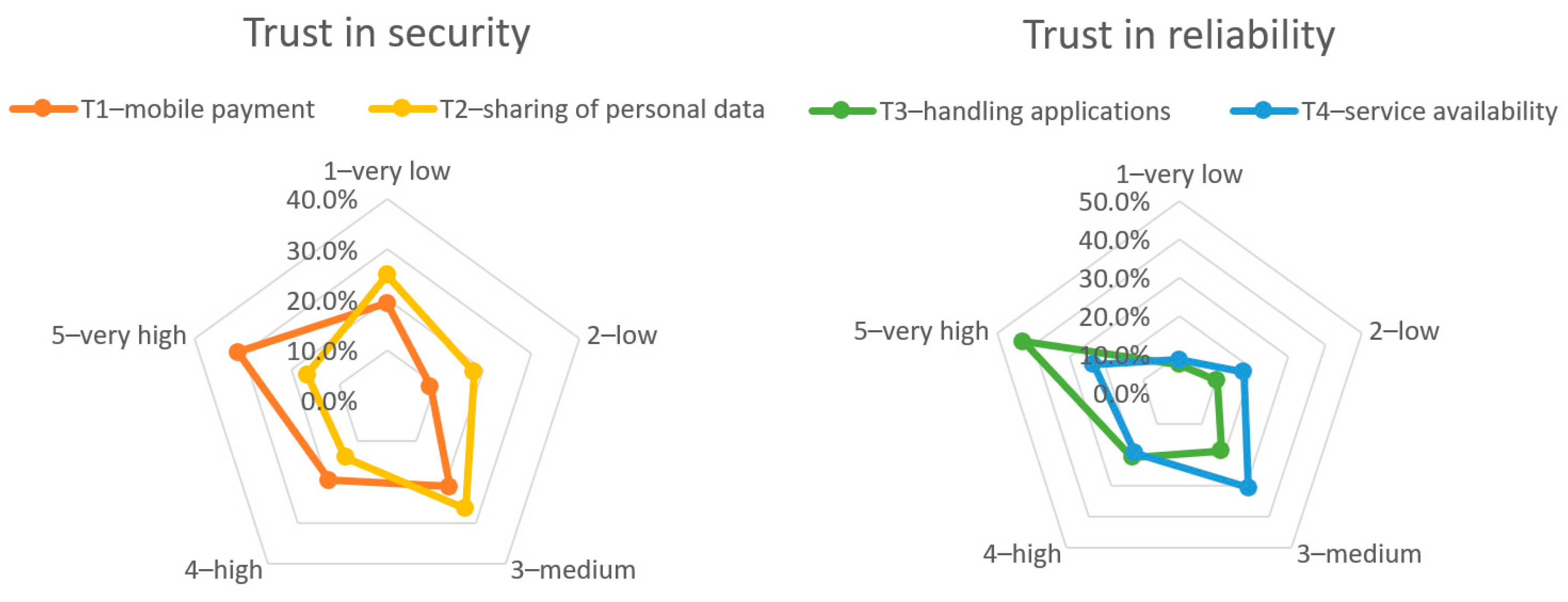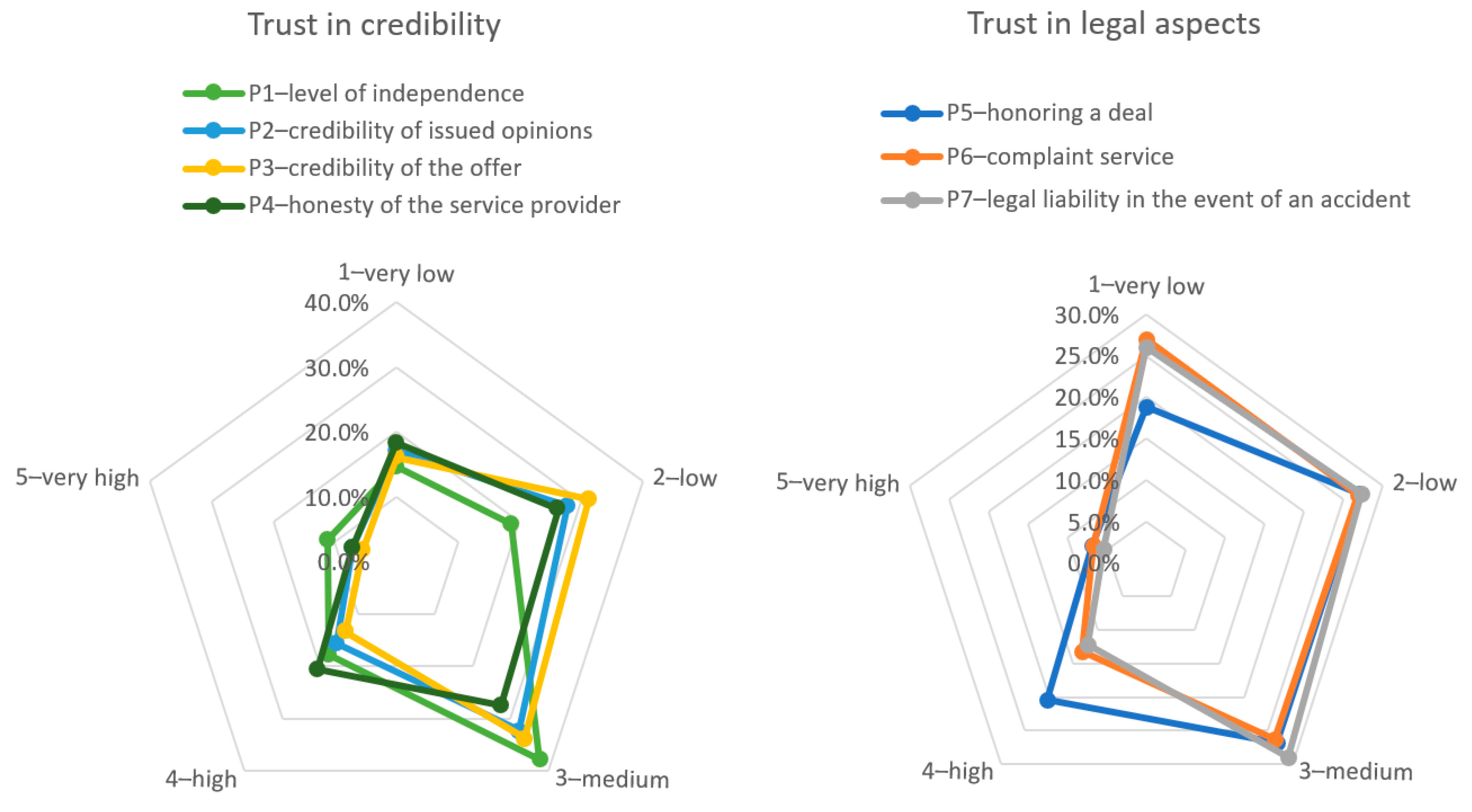4.1. The Level of Trust in Sharing Economy Business Model
In order to check respondents’ level of trust in the sharing economy and the people offering services through the platforms, we posed 11 questions in the third part of the survey.
Questions about trust in technology included:
Questions checking trust in people offering services through sharing platforms included:
P1: level of independence (adapting to conditions set by service providers)
P2: credibility of issued opinions
P3: credibility of the offer
P4: honesty of the service provider
P5: honouring a deal
P6: complaint service
P7: legal liability in the event of an accident
Respondents answered questions on a scale of 1 to 5, where level 1 meant very low trust and level 5 meant very high trust. In further analysis, only those respondents who had heard about sharing platforms were taken into account; a further examined sample consisted of 374 respondents. The reliability of the survey was evaluated with Cronbach’s alpha. Cronbach’s alpha for the obtained variables equals 0.8316. This means that the analysed survey results are a good measure of trust in sharing platforms.
As many statistical tests, analyses, and graphical presentations prepared for the purpose of this research referred to all research questions, it was decided to carry out a joint analysis of all three research questions together. This was a deliberate procedure. Summary answers to research questions are included in the conclusion.
Table 2 presents the average values and standard deviations of the responses of Z generation (18–25 years old) and older (26–55 years old) respondents.
Similarly,
Table 3 presents the average value and standard deviation considering the answers based on the respondents’ gender.
In both tables, in each of the 28 cases, the average values referring to trust in people have a trust level below 3. The average values referring to trust in technology, presented in
Table 2 and
Table 3, have in 13 cases out of 16 a level above 3. This indicates that the respondents trust more in technology than in people (
RQ3). Considering the answers of women and men, in 10 of 11 cases the average values are higher for men than for women. This indicates that men have a higher level of trust in the sharing economy business model in general (
RQ2).
Before verifying the statistical hypothesis, a nonparametric Kolmogorov–Smirnov test was used to verify the normality of all items included in the analysis. This test showed that none of the samples had a distribution close to the normal distribution, with a significance level of p = 0.001. Therefore, the Kruskal–Wallis test was used to verify the statistical hypotheses.
The statistical hypotheses were verified regarding the existence of differences between the responses of the Z generation and older respondents (RQ1).
The following hypotheses for questions T1–T4 and P1–P7 were investigated:
Null Hypothesis (H0a). There is no difference between the answers of the Z generation and older respondents.
Alternative Hypothesis (H1a). There is a difference between the answers of the Z generation and older respondents.
The Kruskal–Wallis test showed that we could not reject the null hypothesis (H0a) at a set level of significance presented in the table. The test results are presented in
Table 4.
The general conclusion is that there are no significant differences between the answers given by the Z generation and older respondents. However, when considering the significance level, we can conclude that for the significance level of 0.05 for questions T2 and P7, we can reject the null hypothesis (H0a). Therefore, for this level of significance, we conclude that there are noticeable differences in the responses of the Z generation and older respondents regarding questions T2, sharing of personal data, and P7, legal liability in the event of an accident. It is worth emphasizing that in these questions the average values differ significantly. For question T2, the average value for the Z generation is 3.02 and for older respondents it is 2.58, whereas for question P7 these values are 2.57 and 2.36, respectively.
Similarly, the Kruskal–Wallis test was performed for the analysed data taking into account the gender of respondents (
RQ2). The hypotheses in this case are as follows:
Null Hypothesis (H0b). There is no difference between the answers of women and men.
Alternative Hypothesis (H1b). There is a difference between the answers of women and men.
Table 5 presents the results of the Kruskal–Wallis test together with the significance level values, for which there is no reason to reject the null hypothesis (H0b). Therefore, for the levels of significance presented in
Table 5, we conclude that there is no rejection of the null hypothesis, that there are no significant differences in the responses of women and men. However, performing the Kruskal–Wallis test assuming a significance level of 0.05 for questions T3, P4, P5 and P7, we get the conclusion that the null hypothesis (H0b) should be rejected. So for questions T3, handling applications; P4, honesty of the service provider; P5, honouring a deal; and P7, legal liability in the event of an accident at a significance level of 0.05 we conclude that there are differences between the answers of women and men. Analysing the average values of each of these questions shows higher average values for men than women, i.e., men show greater trust in the issues considered in the questions.
Next, we analysed the results comparing trust in technology and trust in people as two separate groups.
Table 6 presents the percentages of results obtained regarding trust in the technology used by sharing platforms and trust in people, depending on the age and gender of the respondents (
RQ1, RQ2, RQ3).
Based on the results obtained, a very high level of trust (level 5) in technology is noticeable. When considering all respondents aged 18–25, 28.5% indicated very high trust (level 5). An average level of trust (level 3) was indicated by 24.3% of people and a high level (level 4) by 18.4%.
Similar relationships occur in the division of respondents into age intervals. The largest percentage was a very high level of trust (level 5) by people aged 18–25, 26–35, and 36–45. The exception is respondents aged 46–55, where the largest percentage was level 3 (26.9% of respondents).
To sum up, it can be stated that trust in the technology used in sharing platforms is very high (level 5), except for people over the age of 46, for whom trust can be assessed as medium (level 3).
Figure 11 presents responses regarding the area of trust in technology in the form of average values. Graphic visualization shows that the lowest average value was obtained for people aged 46–55 and it was 2.99.
Figure 12 shows average values of respondents’ trust in technology depending on gender (
RQ2). The higher average value was obtained for men and its value is 3.45.
When analysing the percentage distribution of answers (
Table 6) it can be seen that for men, a very high level of trust (level 5) is observed; 32.5% of respondents indicated this level. For others the level is lower.
For women, the largest percentage is medium trust (level 3), accounting for 27.1% of respondents. Above average levels (high (level 4) and very high (level 5)) were chosen by 42.6% of women. A below average level of trust in technology (level 3) was indicated by 30.4% of women.
To sum up, men assess trust in the technology used in the provision of services at a very high level (level 5), while women assess it at a high level (levels 4 and 5). The average value for men is higher than for women.
The results of the survey regarding trust in people indicate medium or low trust (
RQ1,
RQ3). Detailed percentage results are given in
Table 6. A total of 75.8% of respondents indicated medium (level 3), low (level 2), or very low (level 1) trust in people. When analysing respondents’ answers divided by age group that way, similar results were found in all age groups.
Figure 13 presents average values of trust in the people offering services through sharing platforms.
Similar results of trust in service providers were obtained by analysing the results of the survey based on gender.
Figure 14 shows the average values of trust in service providers using sharing platforms depending on the gender of the recipient.
The average value of trust in people is higher for men than for women and its value is 2.76. The analysis of the more detailed results from
Table 6 shows that in both cases, the largest percentage is medium trust (level 3); however, there is a right asymmetry in the distribution of trust in people. For women, 76.4% indicated medium (level 3), low (level 2), or very low (level 1) trust, while these levels of trust were indicated by 75.1% of men.
The results of the survey shown in
Table 6 indicate low trust (level 2) in people offering services through sharing platforms. Analysing various cases, the results show that over 75% of respondents indicate trust at a medium (level 3), low (level 2), or very low (level 1) level.
Next, the centre of gravity values for respondents’ trust in people and technology are considered.
Table 7 presents the centre of gravity (CoG) values, which were determined on the basis of results (
Table 6) regarding trust in people and technology (
RQ1,
RQ3). As a reminder, the minimum trust value is 1, the maximum is 5.
The centre of gravity values indicate that respondents have more trust in technology than people.
Regarding trust in technology, CoG values in four of the five groups are above 3. In one group, the CoG value of trust in technology is 2.99. If you trust people, all CoG values are below 3. The above statement is also confirmed by the average values presented in
Table 2 and
Table 3.
This relationship, i.e., greater confidence in technology than people, is also seen in
Figure 12 and
Figure 14.
Table 8 shows the centre of gravity values calculated with the division for men and for women. Also, here we can see that CoG values are higher for trust in technology than for trust in people. Once again, the results obtained show higher trust in technology than in people (
RQ1,
RQ3). The CoG values are higher for men than women for both trust in technology and in people. The conclusion is that men have a higher level of trust in sharing economy business models (
RQ2).
Based on the analyses of the results obtained, we can refer to previously submitted auxiliary research questions. For question
RQ1, regarding the level of trust in sharing economy business models, among representatives of the Z generation, the results indicate that this group is characterized by a definitely high trust in technology (73.3% of respondents indicated very high (level 5), high (level 4), or medium (level 3) level of trust in this area) and quite low trust in people (78.1% indicated medium (level 3), low (level 2), or very low (level 1) level of trust in this area) (see
Figure 15).
Referring to question
RQ1, we can conclude that the level of trust in technology in Z generation is consistent with that demonstrated by other age groups, except for respondents aged 46–55 yo, whose trust in this area can be assessed as medium (level 3). The level of trust in people for all age groups is convergent and was assessed as low (level 2) (see
Figure 16).
For question
RQ2, regarding the level of trust in sharing economy business models, the results indicate that men show a slightly higher level of trust than women in both technology and people (see
Figure 17).
When analysing responses to question
RQ3, Which of the two main areas of trust in sharing economy business models, technology or people, are characterized by a higher intensity in all age groups? Trust in technology is assessed at a much higher level (a very high level (level 5) was indicated by the majority of respondents in all age groups, except for those aged 46–55) than trust in people (75.8% of all respondents indicated trust at a medium (level 3), low (level 2), or very low (level 1) level (see
Figure 18).
Further in the paper, individual factors from two main areas affecting the level of trust in technology and people will be analysed.




